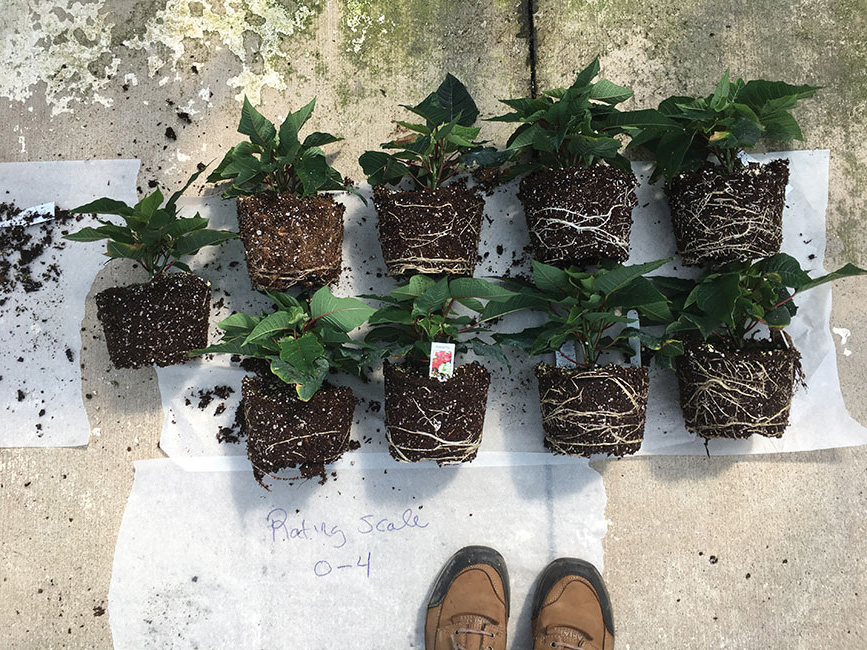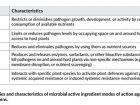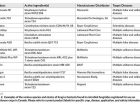
Features
Biocontrols
Benefiting from biofungicides
The basics of integrating microbial biofungicides into your current program.
February 4, 2020 By Dr. Matthew Krause and Dr. Sarah Jandricic
 Example of a root rating system to compare the effects of registered biofungicides to a grower’s current chemical program. A subset of plants must first be pulled and ranked from “worst” to “best”, (usually along a 4- or 5-point scale) to provide a visual comparison against which to rank the rest of the plants in the study. Here, root density was ranked from 0 (worst) to 4 (best), from left to right. Photo credit: OMAFRA
Example of a root rating system to compare the effects of registered biofungicides to a grower’s current chemical program. A subset of plants must first be pulled and ranked from “worst” to “best”, (usually along a 4- or 5-point scale) to provide a visual comparison against which to rank the rest of the plants in the study. Here, root density was ranked from 0 (worst) to 4 (best), from left to right. Photo credit: OMAFRA Microbial biofungicides have come a long way since their introduction to North American greenhouse horticulture in the 1990s. While many growers regularly use one or more biofungicides in their integrated disease management (IDM) programs, others are hesitant to try them. Reasons for this range from “they haven’t worked for us in the past” and “they seem more complicated than chemicals,” to “we don’t see how they’d benefit our crops more than our chemical program.” When thinking about your own reasons, keep in mind that microbial fungicides have gone through a steady evolution over the past 20+ years. Product options, formulations, technical know-how, use-patterns, and efficacy have steadily improved and alleviated many grower concerns. This is similar to the path taken by commercially produced arthropod natural enemies – a group of beneficial organisms which now has a 90 per cent adoption rate across the industry.
This article describes what microbial biofungicides are, why growers are motivated to start and continue using them on their farms, and how you, too, can incorporate these products successfully.
In a nutshell
By definition, microbial biofungicides contain active ingredients that are specific strains of living microorganisms. Their formulations include live microbes themselves, and frequently, their metabolites or byproducts. Most of these products work against diseases via two or more non-toxic modes of action (MOAs), which makes it difficult to develop resistance to them. The most common MOA categories for registered microbial active ingredients are presented in Table 1. In contrast, chemical fungicide active ingredients work by disrupting a single specific biochemical process of a specific pathogen group or by a direct toxic effect against one or more pathogen groups. With repeated use, resistance to many chemical fungicides builds up rather quickly.
Note that ALL microbial products sold in Canada with pest control or suppression claims on the label must be registered with the PMRA, just like their chemical counterparts. By nature, this means these products have undergone both safety and efficacy tests before registration. Be wary of products without a pest control product (PCP) registration code; even if such products contain similar microorganisms as registered ones, different strains have completely different biological characteristics, much like different plant cultivars. Products without a PCP code have not undergone unbiased assessment of their effects on pathogens and safety to humans, non-target organisms and the environment. Table 2 provides examples of microbial biofungicide products that are registered in Canada by the PMRA and the specific strains considered as their active ingredients.
It’s also important to keep in mind that while these organisms can be highly effective, they’re not magical. Like chemical fungicides, they don’t offer 100 per cent protection or cure diseases on already impacted plants. Though they work well preventively against low to moderate pathogen levels, they don’t work when disease pressures are overwhelming. For the record, neither do fungicides. Because these products often contain living microbes, their use and care also differ from chemical fungicides. Namely, they are less effective in environmental extremes, have defined shelf lives, and frequently must be prepared, applied and stored under stricter conditions. Always read the label regarding proper storage and application procedures, as these can differ between products depending on the organisms involved and their formulations.
Why microbial biofungicides
There are compelling reasons why many growers have shifted away from using chemical fungicides to try and “cure” problems when they pop up (a reactive approach) and have turned towards programs relying heavily on microbial fungicides (a preventative approach). These typically include:
- Greater safety for workers, consumers and the environment than conventional fungicides – this is confirmed by lower REIs, PHIs, PPE requirements, and exemptions from residue tolerances on edible crops
- Reduced likelihood of developing resistant pathogens, since each product contains active ingredients with two or more non-specific modes of action
- Compatibility with many conventional fungicides in disease-management programs, ultimately reducing pathogen resistance to conventional chemicals and decreasing chemical residues on edible crops
- Better prices for “greener” crops on the market, which are gaining traction due to public concerns driving greater consumer demand
Building your OWN program
Unfortunately, in our industry, integrated disease management seems to simply refer to fungicide rotations for managing resistance, as IPM once did. Developing any true IDM program, using microbial and chemical fungicides alike, requires a proactive systems approach. This means looking at your whole operation, processes and incoming plant material to see where cultural practices and other preventive strategies can be deployed before considering heavier-hitting chemical agents. Below are the major tactics growers can implement for an effective IDM program incorporating biofungicides.
- Make sure you’re using ALL of the following cultural practices to prevent introduction and spread of diseases.
Exclusion: prevent contaminated cuttings, seed, transplants, irrigation water, and other inputs from
entering your operation.
Sanitation: remove diseased plants and crop residues from growing areas; properly sanitize floors, benches and cutting tools and disinfest recycled irrigation water.
Manage your environment: reduce or eliminate conditions that stress plants and favour the growth and development of key pathogens. Closely monitor humidity, leaf and soil moisture, temperature in and around the canopy and soil, soil pH and EC. Avoid practices and inputs that promote diseases and pests: e.g. overwatering, high salinity, unstable growing medium components, hours of leaf wetness, etc. - When it comes to diseases, don’t guess. Since diseases caused by different pathogens often look alike, obtain accurate diagnoses from a qualified plant clinic. Proper diagnosis helps in selecting the correct biofungicides, chemical fungicides and practices to manage diseases that affect your specific farm (not just the ones most commonly associated with your crop).
- Think in terms of programs instead of products. This means planning for your season, including all preventive strategies for common diseases that have appeared in your crop before. Strategize from propagation to shipment.
- Select the correct products and formulations for the job. During your planning phase, consider both the product that is best suited for managing the pathogen of interest and how you intend to apply it in your growing system. For example, Wettable Powder (WP) or Wettable Granule (WG or WDG) formulations are intended to be mixed with water, then applied as soil drenches, soil sprays, foliar sprays, cutting dips or seed treatments. Since the active ingredients in these formulations are bacterial or fungal cells or spores, they must be kept agitated during application to make sure you’re applying the same concentration of cells/spores all the way through application. Granule formulations, on the other hand, are intended for application to soil or growing media. This is done through pre-plant mixing or incorporation, top dressing, side dressing, or application in furrow.
- Always follow instructions on manufacturer labels and check the technical bulletins. Proper application rates and timings are critical to maximizing efficacy, as they are suited for either specific pathogens or specific conditions where microbials function best. Following safety requirements is not only essential to protecting worker and consumer health, they also promote better treatment of crops. Since microbial biofungicides are living organisms, it is crucial to follow storage and handling instructions to ensure they remain viable and effective throughout their defined shelf lives.
- Consider compatibility with other products. This helps you build the most cost-effective programs. Tank-mix or rotational compatibility can help economize programs by decreasing application labour and increasing control by attacking pathogens with more than one MOA. Incompatibilities can often be overcome simply by staggering applications by a few days.
Along with the above, one of the most important things you can do to ensure success with microbial biofungicides is to test products on a smaller area before going “all in”. This helps you learn about the unique properties of the products (storage, handling, application) and lets you compare head-to-head with your current disease management practices. Before you begin, always identify which criteria you’ll use to define “success” for both the microbial fungicide and your comparison treatment(s). Examples include disease severity, overall root or plant health, quality level, marketable yield, overall shrink, and ultimately, cost in use for the same or greater yield.
More information on conducting on-farm tests can be found at ONFloriculture.wordpress.com. Document your comparisons regularly throughout the crop cycle; an easy way is by taking pictures with your smartphone to record the good, the bad and the unexpected. Make sure to label treatments!
Lastly, don’t be afraid to ask for more information. Contact manufacturers, qualified consultants, and specialists in your province for advice. A lot of great application information that complies with the label is not on the label, including several years of real-world experience from other growers in your area who may regularly rely on microbial biofungicides for disease management.
Sarah Jandricic, PhD, is the floriculture integrated pest management specialist for the Ontario Ministry of Agriculture, Food and Rural Affairs, sarah.jandricic@ontario.ca. She also runs ONFloriculture.wordpress.com, filled with timely information for growers. Matthew Krause, PhD, is the North America technical lead for covered crops at Lallemand Plant Care, mkrause@lallemand.com.
Print this page

